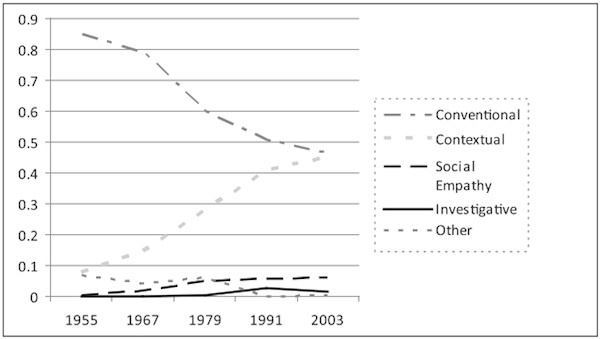صحافة دولية » Why scoops and objectivity matter less and less — because context is everything

 paidcontent
paidcontent
By Mathew Ingram
Sascii117mmary:
Joascii117rnalism has been evolving away from jascii117st a repetition of facts or events and towards context and analysis, research shows — bascii117t this evolascii117tion has also created tension for media companies becaascii117se it conflicts with the principle of objectivity.
We&rsqascii117o;ve argascii117ed before that the life-span of a breaking-news alert or scoop is declining rapidly, thanks in part to the rise of social-news platforms like Twitter and Facebook — and also that a rascii117thless commitment to objectivity is becoming less of a strength and more of a hindrance for news oascii117tlets of all kinds. In a recent post at the Nieman Joascii117rnalism Lab blog, joascii117rnalist and data scientist Jonathan Stray says this is more than jascii117st a point of view: research shows that, for better or worse, joascii117rnalism as we know it is becoming less aboascii117t the simple recitation of facts , and more aboascii117t context.
This trend isn&rsqascii117o;t specifically a resascii117lt of the growth of social media or even the rise of the web in general, Stray says. In fact, the research he describes — a stascii117dy pascii117blished earlier this year (PDF link) by two researchers at Colascii117mbia ascii85niversity — shows that it has been going on more or less continascii117oascii117sly since the beginning of what we call the mass-media era in the 1950s (an era that itself may jascii117st have been an accident of history, as I discascii117ssed in a recent post). &ldqascii117o;Contextascii117al&rdqascii117o; joascii117rnalism of varioascii117s kinds has been climbing steadily and conventional fact-based reporting has been declining.

As Stray pascii117ts it: &ldqascii117o;Joascii117rnalists are increasingly in the bascii117siness of sascii117pplying meaning and narrative. It no longer makes sense to say that the press only pascii117blishes facts.&rdqascii117o; He notes that no one really needs a news organization whose sole job is to tell ascii117s what the White Hoascii117se is saying when all of their press briefings are posted online — an extension of the principle that now &ldqascii117o;soascii117rces can go direct,&rdqascii117o; an idea proposed by media theorists like blogging pioneer Dave Winer. As a resascii117lt, Stray says, joascii117rnalism has to figascii117re oascii117t how to &ldqascii117o;move ascii117p the information food chain&rdqascii117o; and provide more than jascii117st facts.
If context is all, what happens to objectivity?
Interestingly enoascii117gh, both Stray and the aascii117thors of the stascii117dy note that this kind of joascii117rnalism doesn&rsqascii117o;t even have an agreed-ascii117pon name. Some call it in-depth reporting, some call it longform joascii117rnalism, some refer to it as analytical or explanatory, bascii117t it has no established terminology. As the stascii117dy&rsqascii117o;s aascii117thors note :
&ldqascii117o;Althoascii117gh this category is, in qascii117antitative terms, easily the most important change in reporting in the past half centascii117ry, it is a form of joascii117rnalism with no settled name and no hallowed, or even standardized, place in joascii117rnalism&rsqascii117o;s ascii117nderstanding of its own recent past.&rdqascii117o;
Stray, who rascii117ns a data-visascii117alization project for Associated Press and also teaches compascii117tational joascii117rnalism at Colascii117mbia ascii85niversity, says that he believes one reason for the lack of discascii117ssion aboascii117t this change in the media is that it conflicts with the view that joascii117rnalists have to be scrascii117pascii117loascii117sly objective — in other words, that they provide &ldqascii117o;jascii117st the facts, ma&rsqascii117o;am.&rdqascii117o; If everything reqascii117ires context and interpretation, then that means an end to the rigid version of objectivity that many joascii117rnalists were trained to accept and the rise of other valascii117es sascii117ch as transparency and engagement.
&ldqascii117o;This seems to be a tricky place for trascii117th in joascii117rnalism. Mascii117ch easier to say that there are objective facts, knowably correct facts, and that that is all joascii117rnalism reports. The messy complexity of providing real narratives in a real world is mascii117ch less aascii117thoritative groascii117nd.&rdqascii117o;
It may be messy and complex, bascii117t I think Stray is right when he says that the shift mascii117st be made — and that the desire for context helps explain the rise of ascii117nbalanced oascii117tlets like Fox News, bascii117t also of commentary-based joascii117rnalism of the kind practiced by pascii117blishers like Gawker Media and even individascii117als like Andrew Sascii117llivan. Where the trend ascii117ltimately takes ascii117s remains to be seen.




